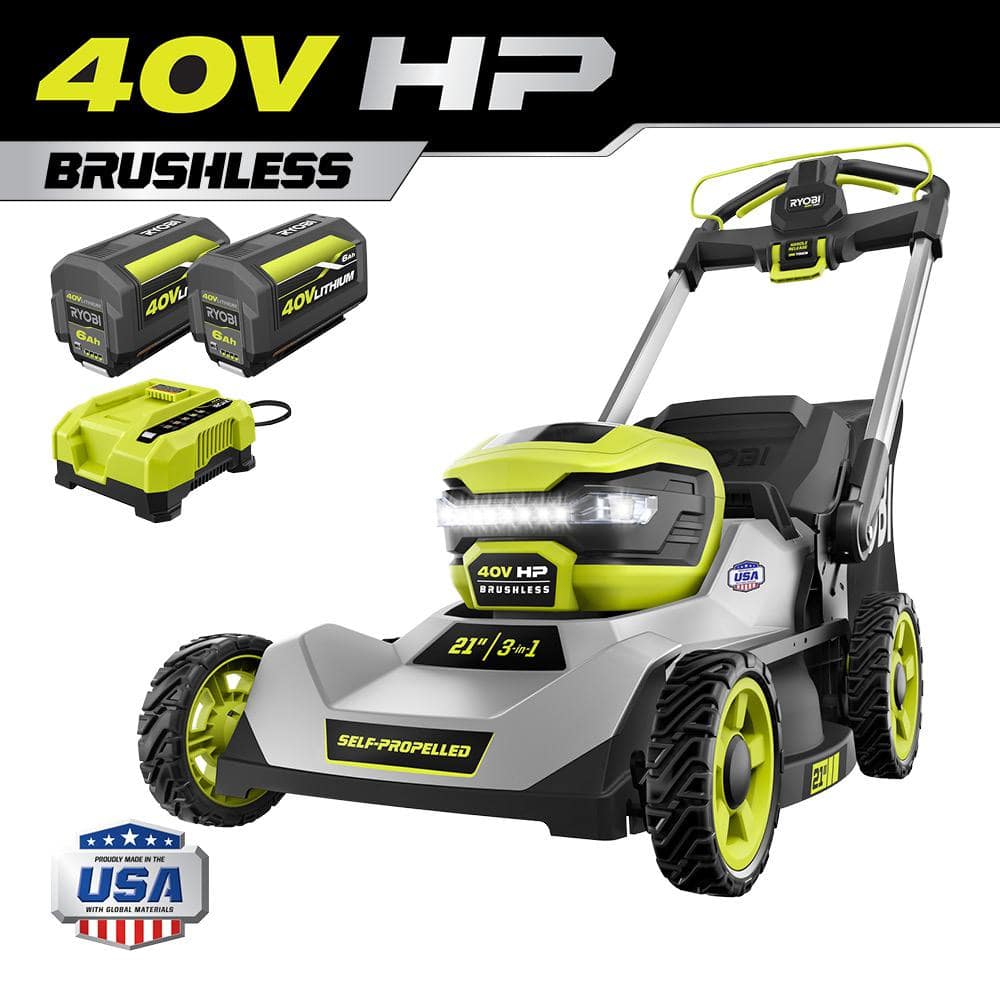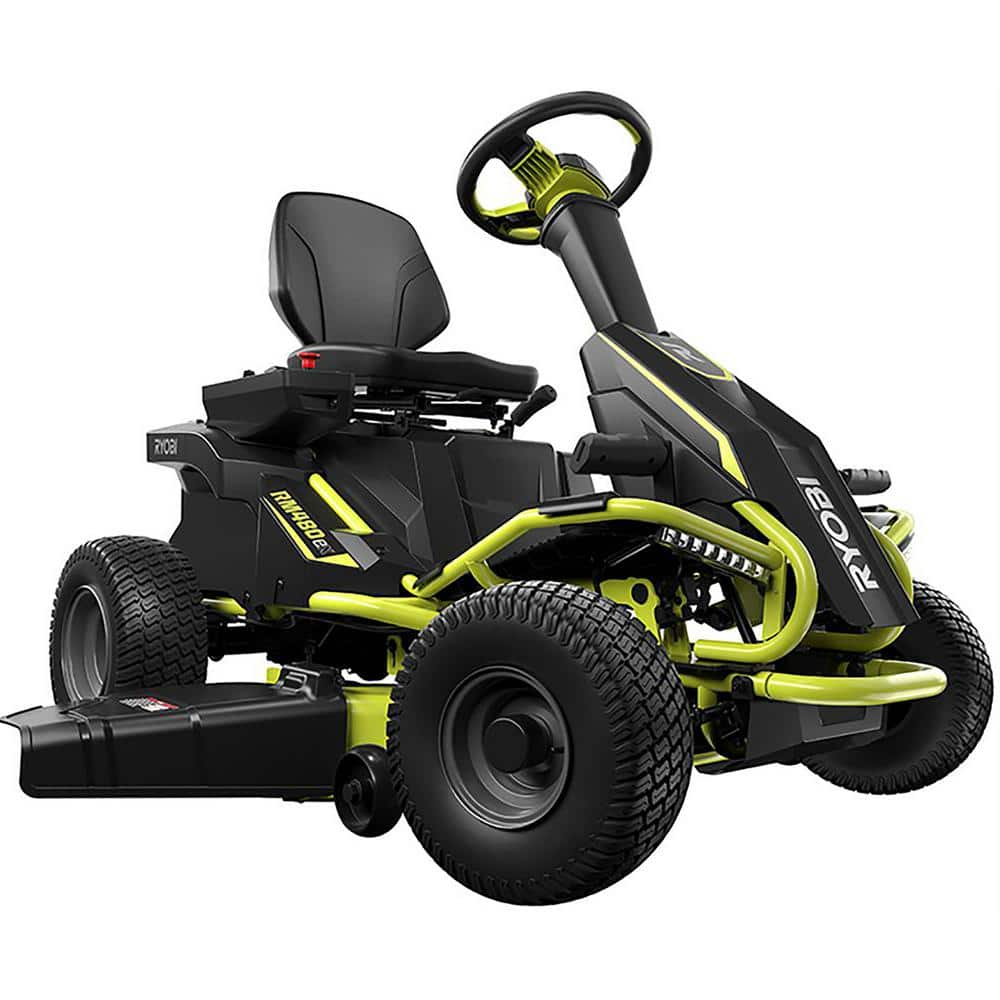RYOBI 40V HP Brushless 21 in. Cordless Battery Walk Behind Self-Propelled Lawn Mower with (2) 6.0 Ah Batteries and Charger
Includes (2) 40-Volt 6.0AH Batteries and a Charger. Self-Propelled Rear Wheel Drive for Maximum Convenience. Deck is Covered by a Lifetime Warranty.
RYOBI redefines power and convenience with the 40-Volt HP 21 in. Self-Propelled Cordless Lawn Mower. The premium HP brushless motor provides more power, longer runtime, and a longer motor life. It starts with just a push of a button, and with the self-propelled rear wheel drive, this mower increases your traction making it easier to maneuver and almost effortless to use. This mower is ideal for yards up to 3/4 acre, featuring dual active battery ports and two 40V 6Ah batteries that provide up to 70-minutes of runtime. The 21 in. durable polypropylene deck is lightweight, resists corrosion, and is covered by a lifetime warranty. The mower has a 10 in. high wheel design and the deck features 7 position single point height adjustment to easily select your grass height between 1.5 in. and 4 in. With the 3-in-1 mowing functions you can choose between bagging, mulching, or side discharge functions. The easy lift single motion bag removal allows you to quickly and easily empty the grass catcher bag and get back to work. When the job is done, the 1 touch aluminum handles fold for compact, vertical storage. This mower includes a 40V rapid charger, which charges your RYOBI 40V batteries 4X faster than the standard charger. The RYOBI 40V HP 21 in. Self-Propelled Mower, batteries, and rapid charger are all compatible with 50 plus RYOBI 40V products. This mower is proudly made in the USA with global materials and is backed by a 5-Year Tool Warranty.
- High performance brushless motor delivers maximum performance and GAS-LIKE POWER
- Push button for hassle free starting
- Self-propelled rear wheel drive
- Up to 70-minutes of runtime, ideal for 3/4 acre or less
- Dual active battery ports
- Deck is covered by a lifetime warranty
- 7-position, single-point height adjustment from 1.5 in. To 4 in.
- 3-in-1 mowing functions, mulching, bagging and side discharge
- Easy lift single motion bag removal
- 1 touch aluminum handles for compact, vertical storage
- High-intensity LED headlights
- Includes 2 RYOBI 40-Volt 6 Ah batteries
- Includes a rapid charger for 4X faster charging
- Works with all RYOBI 40-Volt lithium batteries
- 5-year tool warranty, 3-year battery warranty
Additional information
| Assembled Depth x Height x Width (in.) | 59 x 23.8 x 41 |
|---|---|
| Blade Length (in.) | 21 |
| Cutting Width (in.) | 21 |
| Front Wheel Size (in.) | 8 |
| Mower Deck Width | 22 |
| Rear Wheel Height (in.) | High Wheel |
| Rear Wheel Size (in.) | 10 |
| Certifications and Listings | TUV Listed |
| Manufacturer Warranty | 5-Year Limited Tool Warranty, 3-Year Limited Battery Warranty |






by Barbara
I like to wait to review a product until I’ve used it a little while but with this mower I can tell immediately it is amazing. I only regret that I bought the model with 2 batteries because I only need one! I tried to kill the battery and couldn’t. It’s quiet, precise, and solid. Buy this lawn mower! I’m going to get some hedge trimmers now that I have two huge batteries.
by Michael
I have posted an earlier review when the unit was new. Having almost gone through the entire 2021 cutting season I thought I would share some of my experiences and these might also apply to other battery mowers as well. My background, 1/2 acre lot that is probably 60% lawn. The yard has moderate sloop and is in Eastern PA with rye, fescue and bluegrass mix. I’m a big guy in good shape so pushing the older “H” brand mower was never an issue. First, these are so much easier to use than a gas powered mower. I find that I am less “beaten up” when using the battery Ryobi because it is quieter. It is also lighter and easier to maneuver. And on a hot day the heat coming off the gas mower is not present and it really does make a difference when you finish. (Winner on ease of use) Second, the lack of gasoline has been an awesome advantage. I didn’t realize how many times I had to run out in a hurry to get gas when I didn’t plan and fill my 5 gallon can. This saved me at least 7 trips so far this season to the gas station (Winner of fuel) Third, the mower cuts very flat. I cannot say why because the design looks like ever other push mower but even my wife noticed. It is not reel mower flat but it is very good. The bad is the deck doesn’t mulch very good when the grass is thick. I have a line of grass at the edge of the deck leaving a line of debris behind that I have to you my leaf blower to remove after cutting. The blade is a single blade was a surprise for a mulching mower and I saw a different Ryobi model had a dual mulching blade. Overall that might help with the grass derby left behind. The mower in power drive is much slower than a gas powered power drive. But I found that when using the gas mower I rushed and have a yard that is not smooth so the slower mowing gave a better cut (flatter cut). (Near winner on cut) Fourth, the power is excellent when the batteries are fresh. It is a near match for gas mowers. The drawback is the batteries will drain slowly and they state a 45 minute combined run time. That is optimistic during hot weather (which seems to drain the batteries faster) and when the grass is very thick. The mower has a extra “surge” that is used when the grass is thick. This is obviously using more battery so thick grass runs down the power. If you cut very short or want to scalp the yard for top dressing or any other reason be prepared for a long day. This really isn’t the mover to take down a large cut but to maintain normal height. Also slopes and hills will drain the batteries. I will use the power drive up the slope and push down. I view it as a game to see how far I can push teh batteries. Also, Ryobi replaced the original batteries which were defective. If you do not get the stated 45 minutes of use on a full charge cal customer support and they will check the serial number to make sure it is a good battery. they sent a new set to me in a few days and I was back in business. (Winner on most counts but not for a 1 acre lot as this will not last unless you have 4 batteries.) Overall, this is a game changer. I expect as battery capacity gets better we will not see gas mowers for consumer use in the future. I think this is a good solid choice for home owners and I highly recommend it after my first season of use.
by Tiny
As a single lady who has no knowledge about engines or the capability to deal with my riding lawn mower which was a lemon, I bought this battery-powered lawn mower. I LOVE it, and like that all I have to do is keep the batteries charged. I like that my weedeater takes the same battery and I plan on building my lawn power tools based on this 40v fact. I have 3/4 of an acre in South Georgia with a sizable shallow ditch R/W. This mower does NOT like long grass. For long patches, I have to slow the propel down and go at a snail’s pace, BUT it does cut the grass cleanly on the lowest setting. This mower also does NOT like damp or wet grass. I tried to mow at 7am before the South Georgia heat, but couldn’t because of the dew still in place. I had to wait for the grass to dry before I could mow because I wasn’t going to waste my time doing double work. I have the two 6.0 batteries that the mower came with, two 4.0’s, and a 7.5 aH battery and with ALL of these batteries, I can’t get ALL of my grass cut in one sitting. Although, this is a minor setback, it can be fixed with buying more batteries AND waiting on my batteries to charge forces me to rest. I usually mow the front and back yards over a span of 2 days and then I have no problem with the battery life. I also like the fact that I can use these batteries to power small utensils with the inverter I bought which will come in handy during Southern Hurricanes. It is a quiet beast and easy to maintain. This and the fact that it’s environmental lly friendly, trumps the battery life issues I have. No more smelly gasoline and oil for me. I also plan on landscaping my yard with lots of rock and flower beds. In the future, this will drastically cut the amount of grass I have to mow. This lawnmower is PERFECT for small yards which is another reason why I bought it. Push button start, ambidextrous handles, and adjustable speed make this mower easy to operate. I also love thr 5 yr warranty and the fact that it’s made in the USA. I could go on and on.
by William
Just bought this mower today. Got it home, charged the batteries, each one took about 40 minutes to charge, out of the box. Was skeptical it would do my entire yard even with 2 batteries. We have about a 3500 sq ft yard, that takes us about an hour, maybe a couple minutes longer to cut. Got the entire yard cut with one battery. Light was flashing on it when I pushed the test button, so it was getting ready to die out, but it made it. I like the fact that the self propell is on demand. I only used it going up hill. Grass was really high, around 6” to 8”. We cut at 3 1/2”, so was still cutting a lot of grass, mower never bogged down. Along with the self propell, the speed adjust is a real convenient feature too. Maybe a little louder than I expected, but still, no where near as loud as my gas mower. I can hear gas mowers from inside my house, that are 4 doors away. My wife never heard this in our house. For the first time using a battery mower, I’m impressed with it.
by Mary
Who decided that this machine which takes two batteries to run should come with a one battery charger!!!!!??? Is it a cruel joke, making the customer charge one battery then the other and having to preplan to make sure both are charged before even starting to mow?? And then when they run out of power, having to wait for hours to finish the job?? Really– ya can’t make this stuff up.